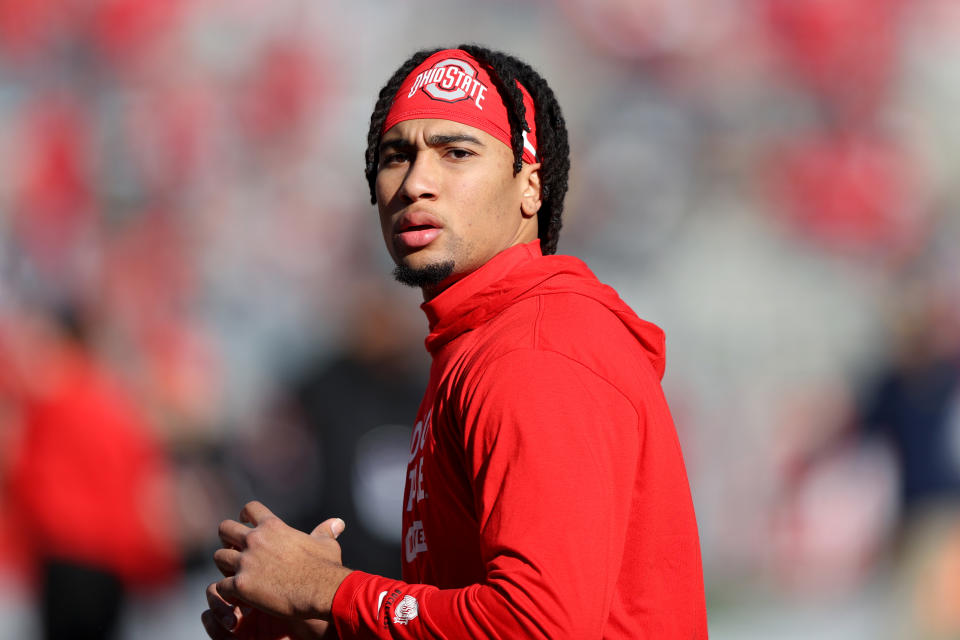Monday is the deadline for players with remaining NCAA eligibility to announce if they wish to make themselves available for spring’s NFL Draft.
Alabama’s Bryce Young and Will Anderson have announced. Same with Georgia’s Jalen Carter, Broderick Jones and Kelee Ringo. So too with Northwestern’s Peter Skoronoski and Clemson’s Myles Murphy and Penn State’s Joey Porter Jr.
Almost every highly rated player has declared for the draft at this point … except one notable exception, Ohio State quarterback C.J. Stroud, who is a contender not just to be a first round selection, but the first pick overall.
Throughout football, the expectation is Stroud will do so before the deadline. He hasn’t yet though. Maybe he dragged it out for drama, or maybe he might signify something that could become a thing in this new era where college athletes are allowed to profit off their name, image and likeness.
Stroud – or someone like him in the future – might actually stay and develop due to the more advantageous financial situation.
To be clear, this kind of decision happened prior to NIL.
In 1997, Peyton Manning was projected to be the No. 1 overall selection yet returned for another season at Tennessee. In 2010, Andrew Luck did the same so he could play again and finish his degree at Stanford. Justin Herbert came back to Oregon for the 2019 season despite being a top-five or at least top-10 selection.
So it’s a rare decision, but not unheard of.
Yet those three all came from affluent (at the very least) backgrounds and weren’t under any financial stress. Stroud has a different situation, raised, along with three siblings, by a single mother.
NIL now offers the opportunity to turn pro free of financial considerations to all star players, no matter how they grew up.


There is nothing in the current marketplace that suggests Ohio State boosters via a collective, or more traditional commercial or sponsor opportunities, would be able to equal the potential fortune of the NFL.
Top-five picks in the 2023 NFL Draft are projected to receive four-year deals worth between $32 million to $41 million (including signing bonuses between $22 million and $27 million).
Getting to the league early also starts the clock on the mega-lucrative second contract. If Stroud proves himself to be as good as scouts project, then he could land a deal that already runs between $30 million and $50 million a year, and will almost assuredly be higher in the future.
It’s why if Stroud decided to stay at Ohio State, he wouldn’t be trading whatever he could earn through NIL this year against his rookie deal. He might come relatively close to equal money over the next 12 months.
He’d really be trading Year 1 (his lowest paid in the NFL) against the final year of his career – be it four, eight or 20 years down the line – that could be one of his highest.
There is simply no comparison.
The money is no longer a zero-sum consideration now though – millions or just tuition, room and board. Neither is development as a player. You’d be hard pressed to convince Manning, Luck or Herbert that they made the wrong decision by returning to college football. Besides the camaraderie and education, they presumably refined their skills so they didn’t just get to the NFL, they were ready to become stars.
Patience can be profitable.
It’s not unusual in baseball and hockey, where college players can be drafted by pro teams yet still play under NCAA rules. And college basketball has already seen a number of marginal NBA prospects return in part due to NIL money, including Kentucky’s Oscar Tshiebwe, the reigning national player of the year.
The same is becoming true in college football.
Michigan boosters, among others, have created a collective called the “One More Year Fund” that doesn’t hide its goal to tip the balance of the go-pro-or-stay-in-school debate for Wolverine players. Its motto channels the old Bo Schembechler promise: “Those who stay, will be paid.”
It directly describes itself as a “crowdfunding campaign designed to retain key Michigan football players, starting with Blake Corum, Cornelius Johnson, Trevor Keegan and Zak Zinter.”
Corum, a running back who suffered a knee injury in November, announced he will be back in Ann Arbor (rather than a mid-round pick). Same with offensive lineman Keegan and Zinter, with Johnson expected to return as well.
Could this work for a likely top-five pick at the most important position on the field though, the kind that provides a huge pop of talent and anticipation to college football?
Stroud already had some nice NIL deals. He drove a $200,000 Mercedes G Wagon this year in an agreement with a local car dealer as well as another contract with Columbus-based clothing brand Express. And that’s just the traditional stuff.
There are no poor star quarterbacks any longer. They may not be as rich as their NFL counterparts, but the promise of hundreds of thousands, if not millions, in NIL money may slow down the talent flow from college to the pros. If nothing else, it gives every player from every background the luxury of choosing development that once was reserved for those from wealthy families.
Maybe C.J. Stroud is the pioneer here. If not, someone will be soon.
